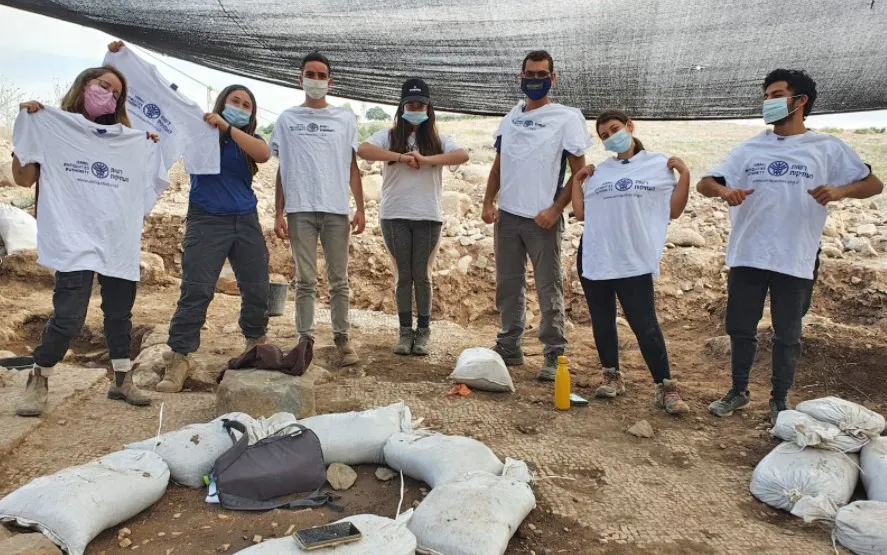Inscription Offers Earliest Evidence of Christianity in Israel’s Jezreel Valley
The fifth-century engraving, found repurposed in a Byzantine building’s wall, references “Christ born of Mary”
:focal(936x780:937x781)/https://tf-cmsv2-smithsonianmag-media.s3.amazonaws.com/filer/73/95/73956283-69f8-493e-8359-e0079c690cb9/140298191_488342795896538_6872159057746737866_o.jpg)
Archaeologists in the northern Israeli village of et-Taiyiba have unearthed a 1,500-year-old Greek inscription that includes the phrase “Christ born of Mary,” according to a statement from the Israel Antiquities Authority (IAA).
As Amanda Borschel-Dan reports for the Times of Israel, researchers led by Tzachi Lang and Kojan Haku uncovered the stone engraving while conducting salvage excavations ahead of construction of a road. The team found the partially destroyed inscription repurposed in the wall of an elaborately decorated Byzantine building. Its text faced inward and would not have been visible to visitors.
Per the statement, the full text of the inscription reads, “Christ born of Mary. This work of the most God-fearing and pious bishop [Theodo]sius and the miserable Th[omas] was built from the foundation.”
The find represents the first evidence of the now-lost church’s existence, as well as the earliest evidence of Christianity’s presence in the Jezreel Valley region.
“We did not know what to expect ahead of the work, but we knew that this was an area where archaeological remains had been found,” IAA archaeologist Yardenna Alexandre tells the Jerusalem Post’s Rossella Tercatin. “When we came across the inscription, we knew we had a church.”
Built in the fifth century A.D., the church predated other houses of worship in the area by around a century. Researchers had previously discovered the ruins of a Crusader-period church and an ancient monastery in the area, but they hadn’t yet found a Byzantine-era church.
Speaking with the Times, researcher Walid Atrash says, “The importance of the inscription is that until now we didn’t know for certain that there were churches from this period in this area.”

According to Ruth Schuster of Haaretz, the scholars suggest that Theodosius, the fifth-century archbishop of the ancient city of Beit She’an, established the church, which is near Mount Tabor, the supposed site of the transfiguration of Jesus—a biblical event said to have underscored Christ’s divinity. The find indicates that Theodosius was building churches in the area earlier than archaeologists had previously thought.
Thomas, the “miserable” individual whose name appears in the text, is a more mysterious figure, though researcher Leah Di Segni tells Haaretz that he might have helped fund the church. While the “miserable” moniker may sound off-putting to modern ears, Di Segni points out that such humble self-assessments were typical of religious inscriptions at the time.
In the statement, Di Segni notes that the phrase “Christ born of Mary”—an invocation intended to protect worshippers from the “evil eye”—often appears at the beginning of early Christian documents and engravings.
“The inscription greets those who enter and blesses them,” Di Segni explains. “It is therefore clear that the building is a church, and not a monastery: Churches greeted believers at their entrance, while monasteries tended not to do this.”
After the et-Taiyiba church’s heyday, the engraving was incorporated into the doorframe of an elaborately decorated two-room building. Outfitted with geometric mosaics, the structure was built by Christian or Jewish residents of Galilee during the Byzantine or early Islamic period.
Prior to its repurposing, the stone block boasted a carved crucifix. As the Times reports, the cross was either intentionally destroyed or damaged in an earthquake. If the former was the case, says Atrash, the builder likely didn’t set out to commit an act of desecration. Instead, he tells Haaretz, “I think maybe the builder didn’t care about the inscription or the cross. They were just in the way.”
In the statement, Atrash adds, “This is the first evidence of the Byzantine church’s existence in the village of et-Taiyiba and it adds to other finds attesting to the activities of Christians who lived in the region.”
/https://tf-cmsv2-smithsonianmag-media.s3.amazonaws.com/accounts/headshot/Isis_Davis-Marks_thumbnail.png)
/https://tf-cmsv2-smithsonianmag-media.s3.amazonaws.com/accounts/headshot/Isis_Davis-Marks_thumbnail.png)